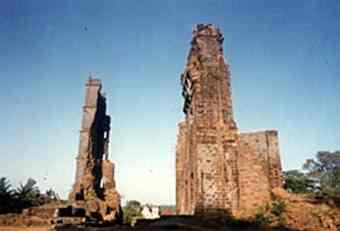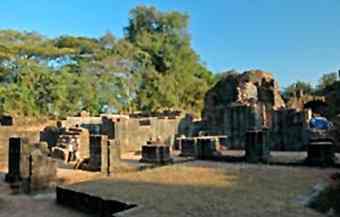Velha Goa (Old Goa) has a number of churches, which have been included in UNESCO list of World Heritage Sites. Among these are the ruins of St Augustine Church.
 Today it is just a 400 year old lonely tower of 46 meters (150 feet) overlooking the old city. It is a mere skeleton of the great church and is in ruins. Yet it is impressive. This colossal, four-storied, arched tower built of laterite, once formed part of the facade of the church of St. Augustine. The ruins of eight chapels, four altars and extensive convent with numerous cells may be seen below it. The portico and the tower are still present and look absolutely splendid.
Today it is just a 400 year old lonely tower of 46 meters (150 feet) overlooking the old city. It is a mere skeleton of the great church and is in ruins. Yet it is impressive. This colossal, four-storied, arched tower built of laterite, once formed part of the facade of the church of St. Augustine. The ruins of eight chapels, four altars and extensive convent with numerous cells may be seen below it. The portico and the tower are still present and look absolutely splendid.
The ruins first afford the tourist, a glimpse of the high altar, with its large gilt tabernacle sheltered within an arch, through a screen of arched piers. Vestiges of most of these piers were visible until recently; they supported a spacious choir which could have accommodated a large number of Augustinian monks. Now under the broken arches, locals sometimes gather and talk. There was also a barrel vault, whose enormous weight unfortunately hastened its collapse. It was traditional to bury the dead from noble families inside the church itself, close to the sanctuary holding the altar and there are quite a number of graves covered with carved stone slabs.
 When it was completed in the early years of the 17th century in 1602, this grand Church was recognised as one of the three great Augustinian churches in the Iberian world, the other two being the Basilica of the Escorial in Spain and St. Vincente de Fora in Lisbon.
When it was completed in the early years of the 17th century in 1602, this grand Church was recognised as one of the three great Augustinian churches in the Iberian world, the other two being the Basilica of the Escorial in Spain and St. Vincente de Fora in Lisbon.
During construction, the high vault fell down twice. However, the Italian architect built it again and he and his only son stood under the vault and asked for heavy cannon fire to test the stability of the structure. It did not fall down.
In 1835 the church was abandoned as a result of the expulsion of the Augustinians from Goa by the authorities and the Portuguese government ordered its demolition. The bell of the church, was removed to the Fort Aguada Light House initially (1841-1871) and in 1871, transferred to the Church of Our Lady of the Immaculate Conception, Panaji. This functioning bell weighs about 2,250 kilograms.
After being given up by the Augustines, the church was used for missionary and charity work by the charitable institution of the Misericordia for quite a while. However, the buildings finally fell into neglect. This resulted in the collapse of the vault on September 8, 1842. As a direct result of all these occurrences, the Goa Government appropriated the property and sold the materials of the remains of the church in 1843.
In 1846, the main vault of the church collapsed and the convent rapidly decayed. The facade collapsed on August 8, and August 19, 1931 and whatever was left of the the facade of the church including the 46 meters tall tower fell in 1938. By this time, many of the valuable articles had been either sold or lost or dispersed across other churches in Goa.
Somewhere beneath these crumbling stones was hidden the missing corpse of Queen Ketevan of Georgia. The Archaeological Survey of India (ASI) was looking for her grave for the last 15 years at the request of the Georgian government, for whom Queen Ketavan (now St.Ketavan) is the patron saint.
In 1613, the Emperor of Persia Shah Abbas, led an army to conquer the Georgian kingdom and he took Queen Ketevan as prisoner. Ketevan, was martyred in 1624 after refusing to convert to Islam or to marry her captor, who had her flesh torn off with hot tongs! She was killed most brutally. According to an account, her brains were boiled in a giant kettle! Her remains were recovered and hidden by Portuguese clerics in Persia, who then spirited it to Goa. According to historians , the queen’s right hand and right arm were buried in St Augustine church in Goa while other relics were buried in a Georgian orthodox church cathedral in Georgia.
A team of Georgian and Archaeological survey of India experts, in a joint effort, found the relics from under the window of the church in 2006. DNA tests on the remains are being done under the auspices of the ASI.
But the hoary church may yet have many untold stories which lie buried the debris of the past. What remains of the five storey tall tower is thankfully being conserved against all odds for future generations.
Author: Antony Kuriakose | Source: Deccan Herald [July 18, 2010]